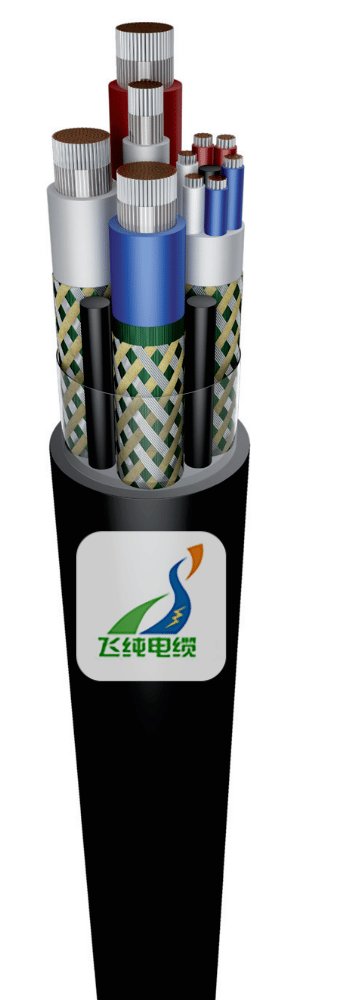Type OnGcekż-G Mining Cable 0.6/1 kV
Power cables for mobile and portable receivers. Screened mining cables


1. Conductor Configuration
The cables come in two conductor arrangements:
7-Conductor Version:
• 3 working (current‐carrying) conductors
• 1 protective conductor
• 3 auxiliary conductors10-Conductor Version:
• 3 working conductors
• 1 protective conductor
• 6 auxiliary conductors
2. Electrical Parameters (Unit Values)
For use in mining applications (where the ambient temperature does not exceed +25 °C), the cables’ electrical performance has been characterized for different working conductor sizes. Key unit parameters (measured per kilometer) include:
Inductance:
– Ranges from about 152 mH/km (for a 25 mm² conductor) up to 345 mH/km (for a 95 mm² conductor).
Inductive Reactance:
– Typically around 0.28–0.30 Ω/km, with only slight variation as the conductor’s cross-sectional area increases.
Capacitance to Earth:
– Two values are provided for each conductor size. One set of values (decreasing slightly with increasing size) is around 0.094 µF/km down to 0.088 µF/km, while a second set (increasing with size) ranges from about 0.40 µF/km to 0.56 µF/km.
These figures help engineers assess the cable’s behavior under alternating or direct current conditions.
3. Physical and Construction Characteristics
Additional construction details specify the cable’s mechanical and physical properties:
Outer Jacket (Tire):
– The nominal thickness of the external rubber jacket is 0.41 mm.
– The maximum permissible average external diameter is specified (varying from about 1.5 mm to 2.0 mm, depending on the cable’s size).
Conductor Resistance:
– The maximum resistance of a working conductor (measured at 20 °C) is given; for example, a cable with a 25 mm² working conductor might have a resistance of around 16 Ω/km, while larger sizes have higher values.
Weight:
– The approximate mass of the cable per 1 km varies with the cable configuration and conductor size, ranging from about 2400 kg up to 6600 kg.
Additional Details:
– The tables also include specifics on the nominal cross-sectional areas of the working, protective, and auxiliary conductors, the insulation thickness, and the maximum allowable diameter for the individual strands of the conductors.
4. Application
These cables are designed primarily for powering machines in opencast (open-pit) mining operations. Their robust construction—including individually shielded conductors and durable insulation—ensures reliable performance in harsh industrial environments.

Cable Construction Overview
Conductors (Wires):
The cable’s working, protective, and auxiliary conductors are made from tinned, multi-stranded copper wires that meet Class 5 standards (PN-EN 60228).
Separator:
A polyester film is placed on the working conductors to keep them separated and organized.
Insulation:
The conductors are insulated with heat-resistant rubber (IEP type) as specified by PN-89/E-29100.
Screening Layers:
Both the working and auxiliary conductors feature a conductive screen. This screen is created by applying a layer of conductive tape and a braid made from tinned copper wires (each 0.30 mm in diameter) combined with plastic fibers. The plastic component covers at least 30% of the screen.
Additionally, the auxiliary conductors have an extra rubber sheath (made of IZ or IEP rubber per PN-89/E-29100) on their core.
Inserts:
The cable core is filled with vulcanized rubber inserts. These inserts are color-coded:
Working conductors: blue, natural, and red.
For three auxiliary conductors: one each of blue, natural, and red.
For six auxiliary conductors: two blue, two natural, and two red.
Jacket (Outer Layer):
The outer jacket, known as the “tyre,” is made from ON-4 type rubber according to PN-89/E-29100, and it is black in color.
Cable Markings and Types
OnGcekż-G:
This marking means the cable is designed for electrical power distribution with the following features:Copper conductors with heat-resistant rubber insulation (Gc).
A flame-retardant rubber jacket (On).
Screened conductors (ekż) and suitability for mining applications (G).
OnGcekż-GW:
This is similar to the above cable but includes an additional waterproof feature (W).
Example Marking:
A seven-conductor cable for 0.6/1 kV might be marked as “OnGcekż-G 3x70+35+3x4 mm.” This indicates:Three working conductors each with a cross-section of 70 mm²,
One protective conductor of 35 mm²,
Three auxiliary conductors each of 4 mm².
The marking follows the standard ZN-96/MP-13-K1172.
Technical Characteristics
Operating Temperature:
Maximum cable temperature is +90 °C.
Voltage Ratings:
Working conductors are rated up to 3.2 kV.
Auxiliary conductors are rated up to 2 kV.
Auxiliary Conductor Resistance (at 20 °C):
For a 2.5 mm² conductor: up to 8.21 Ω/km.
For a 4 mm² conductor: up to 5.09 Ω/km.
Additional Note:
For working conductors with a nominal cross-section greater than 6 mm², the inner layer may use untinned wires.
Cable Core Composition:
The core is built around a bare protective conductor.
It includes three screened working conductors and either three or six auxiliary conductors, all combined under a common sheath and screen.
This assembly is filled with vulcanized rubber inserts and wrapped in an estrafil tape, which serves as a binding layer.
Packaging:
The cables are typically delivered on drums.
This explanation rephrases the technical details into an easier-to-understand format, covering the construction layers, markings, and main characteristics of the cable.






Type OnGcekż-G Mining Cable 0.6/1 kV Power cables for mobile and portable receivers.
These cables are engineered for harsh mining environments, available in both high-voltage (6/10 kV) and low-voltage (0.6/1 kV) versions, featuring copper conductors insulated with heat-resistant rubber, a conductive rubber shield, and a flame-retardant outer jacket. They come in configurations of 7 or 10 cores—including working, protective, and auxiliary conductors—and comply with stringent industry standards, ensuring reliable performance under both AC and DC loads in extreme conditions.
6/30/20214 min read
